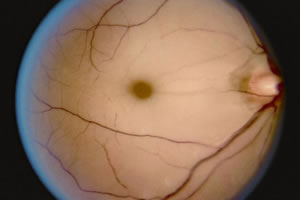Retinal Artery Occlusion
What is a retinal artery occlusion?
The retinal arteries are blood vessels that supply the retina with oxygen. For the retina to function properly, it must have an adequate blood supply at all times. When a retinal artery becomes blocked, the portion of the retina supplied by that artery becomes permamently damaged. The retina that lacks blood supply becomes whitened shortly after the central retinal artery becomes occluded. The whitening resolves within the next few weeks.
Are there more than one type of retinal artery occlusion?
Yes. There are two types of retinal artery occlusions: central and branch retinal artery occlusions.
How do the two types differ?
 A central retinal artery occlusion (CRAO) results when the main artery that supplies the retina with oxygen becomes blocked. It causes sudden, severe visual loss. The photograph to the right shows retinal whitening that we typically see with a central retinal artery occlusion. The brownish spot in the center is known as a “cherry red spot” and is a typical finding in central retinal artery occlusions:
A central retinal artery occlusion (CRAO) results when the main artery that supplies the retina with oxygen becomes blocked. It causes sudden, severe visual loss. The photograph to the right shows retinal whitening that we typically see with a central retinal artery occlusion. The brownish spot in the center is known as a “cherry red spot” and is a typical finding in central retinal artery occlusions:
A branch retinal artery occlusion (BRAO) is a blockage of a branch of the central retinal artery. It usually causes darkness in the upper or lower part of the vision, but the central vision often remains good.
What causes a retinal artery occlusion?
There are many possible causes of retinal artery occlusion. The most common causes are thought to be small particles that travel in the bloodstream and become lodged in a retinal vessel and small clots that develop within a retinal artery. However, there are many other possible causes of retinal artery occlusion, including abnormalities in blood clotting, migraines, and many more.
What kind of testing should be done?
Whenever a CRAO occurs, certain testing should be done in an effort to determine the cause. This evaluation includes various blood tests and ultrasound of the arteries in the neck and heart. Sometimes, a clot is identified in an artery in the neck or in the heart. Treatment for such a clot could help to prevent a stroke. If a CRAO occurs in an elderly patient, temporal arteritis might be the cause. This disorder causes inflammation in the blood vessels throughout the body and can cause visual loss in both eyes. Untreated, temporal arteritis can even be life-threatening. Specific blood tests can be obtained to check for temporal arteritis, and if the doctor is suspicious of this disease, a biopsy of the temporal artery can be taken to confirm or rule out the diagnosis. A CRAO in a young person is unusual, so extensive testing would be done to determine the underlying cause in such a case.
Like a CRAO, a BRAO can be caused by a number of underlying conditions, so blood testing and ultrasounds are often performed to determine the cause.
How is a retinal artery occlusion treated?
Our treatment options for CRAO are, unfortunately, quite limited. A few maneuvers can be attempted in the office, but the prognosis is almost uniformly poor despite any particular intervention. The doctor will watch closely, with periodic examinations, to see if any abnormal blood vessels grow in the eye. If abnormal blood vessels grow in the front part of the eye, they can cause the pressure in the eye to become very high, resulting in severe pain and even worse vision; if they grow in the back part of the eye, they can cause bleeding inside the eye. If abnormal blood vessels are identified on examination, the doctor may recommend laser treatment and/or intraocular injections to stop their growth and, hopefully, prevent the complications they can cause. Some doctors do not believe that a CRAO can cause severe glaucoma. While it is quite rare, we have observed a few such cases. If a CRAO is found to be due to temporal arteritis, the patient is treated for months to years with prednisone, an anti-inflammatory medication, to prevent visual loss in the other eye as well as damage to blood vessels throughout the body, which can be life-threatening.
Like a CRAO, there is no known treatment to improve the vision lost due to a BRAO. Also like a CRAO, abnormal blood vessels rarely grow inside the eye due to a BRAO. Laser treatment and/or intraocular injections can be performed in an effort to stop their growth.


